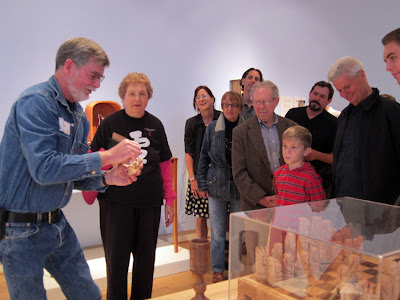My client came to me wanting to replace a large and imposing bed made in the Mission style from fairly dark wood. The old bed was visually heavy, and dominated the room. What she wanted was a more feminine design that was much lighter, both visually and color-wise. What we came up with was a light and airy take on the iconic Japanese Torii gate.
A great example of the classic Torii gate.
The house has many classicly Arts & Crafts features, including lots of Douglas fir trim work. We explored several possible design directions in varying degrees of Mission/Arts & Crafts and Asian styles. After a few iterations, we ended up a mixture - a Torii-inspired bed with more Missiony nightstands, which we lightened and made a little more feminine by adding a few curves. To maintain a lighter feel, the set will be made of maple, with Douglas fir panels.
Our final design.
After turning a handful of 10' boards into a pile of part blanks, construction started with the foot board sub-assembly. The first task was to create dadoes for the dark wood accent squares. Because the profiles of the pieces they join are curved on both sides, these had to be milled while the part blanks were still square.
Steps for attaching the dark squares.
The dadoes were made using a simple jig and a top-bearing router bit. As you can see, the first step was to make shoulder cuts with a handsaw (shown by the arrow). Then about a third of the material was removed with a chisel. Next, the jig, whose "fingers" were the exact size of the dadoes with the correct spacing, was clamped to the workpiece and waste material was removed with a router. Once this was done, the curves could be shaped. Layout for the curves was accomplished with a simple flexible batten and a couple of small nails.
Laying out a curve.
Once the parts were shaped, the rest of the assembly was constructed using half-lap joints. Cut with a similar technique used for the accent dadoes, shoulder cuts were made by hand, the majority of the waste removed with a chisel, then the joint was finished with a top-bearing router bit (using the shoulder cut as the "template"), and fine-tuned by hand with a chisel.
The half-lap joints of the foot board.
The head board will be made the same way, with accent squares and half-laps. Stay tuned.....
















